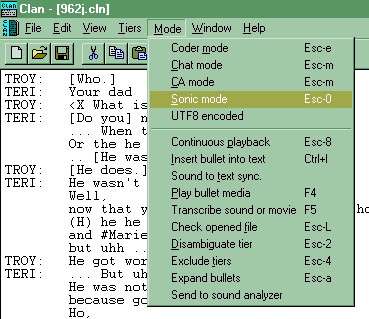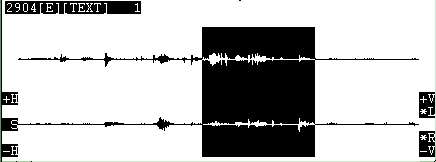Associating a text file with an audio file
The first step to timestamping in CLAN is to associate your text file with an audio file. There are several "modes" you can work in when using CLAN: Coder mode, Chat mode, CA mode, and Sonic mode. For our purposes, we will only need to be familiar with Chat mode and Sonic mode. CLAN opens to Chat mode by default but you must be in Sonic mode for timestamping. To enter Sonic mode, go to the "Mode" menu and select "Sonic" mode. You can also press Esc-0 (press the keys in succession, do not hold down the Esc key). To open in Sonic mode, CLAN must know what audio file to use, so it will prompt you to choose an audio file to associate with your text file. Choose the appropriate audio file and click "open".

The Sonic Mode View
When CLAN enters into Sonic mode, the waveform will appear at the bottom of the window underneath the text. CLAN shows the waveform in stereo-- the top waveform represents the left channel and the bottom waveform represents the right channel. To the left of the waveform are three black boxes. From top to bottom they are "+H, S, and -H" To the right of the waveform, there are two black boxes, with four letters "+V, *L, R*, and -V". Single-clicking on these boxes performs various functions explained below:
+H - If we think of the waveform as a graph, the x or horizontal axis represents time while the y or vertical axis represents amplitude. Clicking on the H+ button decreases the amount of time displayed in the waveform window, stretching the waveform horizontally. This allows you to zoom in horizontally on a particular part of the waveform.
S - This button inserts a bullet into the text representing the beginning and end time of the selected waveform (see sections entitled "Selecting a Portion of the Waveform" and "Inserting a Bullet")
-H - This button increases the amount of time displayed in the waveform window, shrinking the waveform horizontally. This allows you to zoom out horizontally on a particular part of the waveform.
+V - This button decreases the amount of amplitude displayed in the waveform window, stretching the waveform vertically. This allows you to zoom in vertically on a particular part of the waveform.
*L - This button mutes and un-mutes the left channel of audio. When the channel is muted the asterisk will disappear. When the channel is un-muted the asterisk will re-appear.
*R - This button mutes and un-mutes the right channel of audio. When the channel is muted the asterisk will disappear. When the channel is un-muted the asterisk will re-appear.
-V - This button increases the amount of amplitude displayed in the waveform window, shrinking the waveform vertically. This allows you to zoom out vertically on a particular part of the waveform.

Navigating the Waveform
Navigating the waveform is very easy. Simply use the scrollbar at the bottom of the window. Unfortunately, CLAN seems to be a little buggy in this respect and the position of the scroll bar does not necessarily accurately reflect your position in the sound file.
Selecting a Portion of the Waveform
To select a portion of the waveform, click the mouse, drag over a portion of the waveform, and release the mouse. The selected portion of the waveform will be highlighted in black and the waveform will appear white. You can adjust the beginning or the end of the portion by holding down the Shift key and dragging the mouse on the side of the portion you wish to adjust. CLAN will repeat the portion of waveform you have selected each time you edit it.

Inserting a Bullet (i.e. Timestamping)
Having selected the correct portion of the waveform, you now must insert a bullet into the text. A bullet in CLAN contains the timestamping information. You will want the text cursor to be next to the text you wish to match with the audio. There are two ways to create a bullet. You can press the black S box to the left of the waveform or you can press Ctrl+I (hold down the Ctrl key). You can also go to the "Mode" menu and select "Insert bullet into text." The bullet will appear to the left of the text.
To play the bullet, position the text cursor on the same line as the bullet and press the F4 key. You can also play a bullet by going to the "Mode" menu and selecting "Play bullet media." CLAN highlights the corresponding section of the waveform when you select the bullet.

Bullet Views and Editing Bullets
CLAN has two bullet views. The default view is to hide the bullets. In other words, only a bullet appears, hiding information inside of the bullet. You can expand the bullet by going to the "Mode" menu and selecting "Expand Bullets" or you can press Esc-a. To hide the bullets press Esc-a again or go to the "Mode" menu and select "Hide Bullets."
When the bullet is expanded, you can examine the information contained in it. The inside of the bullet will look like this:

After %snd: CLAN records the name of the audio file in quotation marks. The name of the audio file is followed by an underscore, the beginning time of the bullet in milliseconds, another underscore and the ending time of the bullet in milliseconds.
There are two ways to edit a bullet after it has been created. First, you can edit the bullet manually by changing the beginning and end times. You can also edit the bullet by holding down the Ctrl key and pressing either the forward or backward arrow key. Make sure the cursor is next to the bullet you wish to edit. Pressing Ctrl+forward arrow moves the start of the bullet back by twenty-five milliseconds. Pressing Ctrl+backward arrow moves the start of the bullet forward twenty-five milliseconds. To edit the end of the bullet hold down Ctrl+Shift and use the arrow keys in the same manner.
These functions are especially useful in fine-tuning the timestamping. Unfortunately, CLAN does appear to be a little buggy, so on either slow or Windows 98 computers (or perhaps only my computer) the Ctrl+Shift command may crash your computer! SO SAVE YOUR WORK OFTEN!!! I haven't found this to be a problem with faster/more updated computers.
Copying Bullets
CLAN will only let you copy bullets when the bullet is expanded. To do this press Esc-a or go to the "Mode" menu and select "Expand bullets."
Tips and Tricks
At times you may lose your place in the waveform and need to highlight section of the waveform you were last working on. The easiest way to do this is by positioning the cursor next to the bullet and using the Ctrl-arrow key technique. This will highlight the section of the waveform that corresponds to that bullet. It will also change the beginning of the bullet by twenty-five milliseconds so don't forget to change it back! (Simply press the opposite arrow key).
You will need to manually edit the bullets in order to assure that your intonation units are seamless. The end of one intonation unit must be the same as the beginning of the next (unless you are dealing with speaker overlap). Thus, you may find it necessary to accurately find the beginning/end of the intonation unit. I have found that the easiest way to do this is to use the Ctrl-arrow key technique to move the beginning of the bullet until I hear the end of the previous intonation unit. When I hear the end of the previous intonation unit, I move it forward 25 or 50 milliseconds until I don't hear it anymore. Then I manually edit the end time of the previous bullet so that it is the same as the beginning time of the current bullet. Thus you have found the accurate end time of the previous intonation unit and the beginning time of the current intonation unit.
If you accidentally press F4 in a section of the text where you have not yet inserted a bullet, CLAN will search until the end of the file to find a bullet. If there are none, it will prompt you to choose an audio file. If you press cancel, the waveform will still be displayed and you will still be able to insert bullets. However, the name of the sound file will not be in the bullet and it will not repeat the bullet when you press F4. It will again ask you to choose an audio file. To remedy this situation either select the correct audio file when it prompts you or press cancel and edit the last bullet you were working on. This will reset CLAN to the proper file name.
Sometimes CLAN has trouble displaying the waveform correctly. Either part of the waveform will disappear or it will not correctly display an area you are trying to highlight. To fix this, move the waveform using the scroll bar at the bottom of the window. CLAN will then refresh the waveform image.
Benjamin Wheeler
Rice University
July 13, 2003